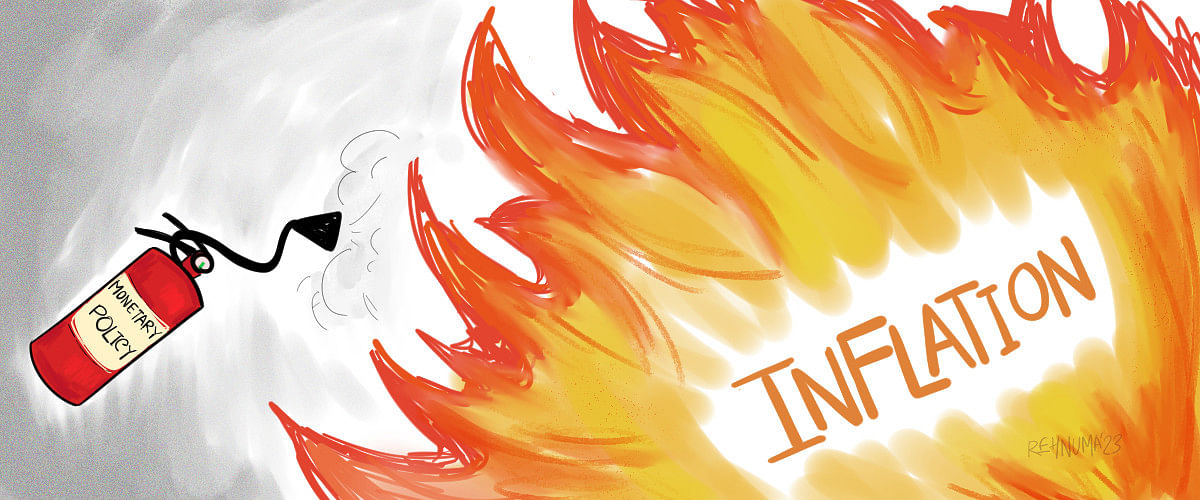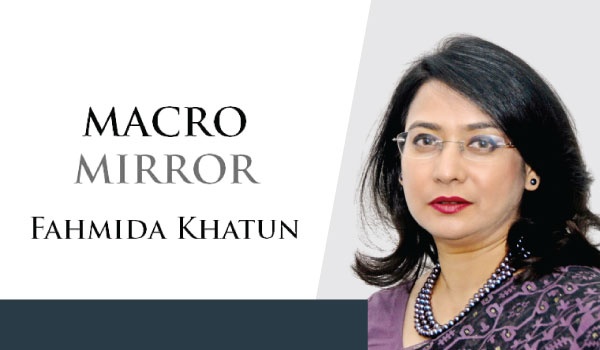Originally posted in The Daily Star on 3 July 2023

The lack of coherence between the fiscal and monetary policy stances will make the monetary policy less effective in controlling inflation.
 The Bangladesh Bank’s monetary policy statement (MPS) for the first half of FY2023-24, in effect since July 1, is focused on containing inflation, with a stated strategy to reduce the aggregate demand while continuing supply-side interventions. The central bank aims to achieve its objectives by adopting a contractionary monetary policy stance. The new MPS brings forth four areas of changes: establishment of a policy interest rate corridor; introduction of a reference interest rate for lending; unification of exchange rates; and adoption of a revised approach to calculating the gross international reserves, aligning with the guidelines outlined in the Balance of Payment and International Investment Position Manual.
The Bangladesh Bank’s monetary policy statement (MPS) for the first half of FY2023-24, in effect since July 1, is focused on containing inflation, with a stated strategy to reduce the aggregate demand while continuing supply-side interventions. The central bank aims to achieve its objectives by adopting a contractionary monetary policy stance. The new MPS brings forth four areas of changes: establishment of a policy interest rate corridor; introduction of a reference interest rate for lending; unification of exchange rates; and adoption of a revised approach to calculating the gross international reserves, aligning with the guidelines outlined in the Balance of Payment and International Investment Position Manual.
The change in approach for a major monetary tool such as the interest rate is a welcome move. For a long time, the central bank remained rigid in letting these rates be determined by the market, based on the consideration that doing so would hamper the private sector’s competitiveness, which could ultimately hamper growth. However, without improving structural bottlenecks and governance, a low interest rate does not necessarily increase competitiveness in the economy. The new MPS shifts to a market-driven reference lending rate for all categories of bank loans, replacing the lending rate cap that was enforced in April 2020. This shift is expected to promote competitiveness within the banking sector and cultivate a favourable lending climate for both businesses and individuals.
The new MPS states that the Bangladesh Bank will transition from a monetary targeting framework to an interest rate targeting one. Under this, the interbank call money rate will closely align with the policy rate, ensuring stability. Simply put, the interbank call money market serves as a short-term financial market where major institutions like banks, mutual funds, and corporations can engage in borrowing and lending activities at interbank rates (the rate at which banks borrow funds from one another).
In line with adopting an appropriate monetary policy approach, the central bank has chosen to raise the policy rates. This move is intended to raise the cost of borrowing, with the aim of curbing the impact of CPI (consumer price index) inflation.
From now on, the Bangladesh Bank will announce the reference lending rate, referred to as “SMART,” on a monthly basis through its website. This rate is determined based on the six-month moving average rate of treasury bills. Banks and non-bank financial institutions (NBFIs) will have a margin applied to this rate. For banks, the margin can be up to three percent, while for NBFIs, it can be up to five percent. However, lending activities for cottage, micro, small, and medium enterprises (CMSMEs) as well as consumer loans may be subject to an additional fee of up to one percent to cover supervision costs. The interest rates for credit card loans will remain unchanged.
With liquidity crunch in banks, the government relied on borrowing from the central bank in FY23. This possibility exists in FY24 as well. This will fuel inflationary pressure further.
For a long period, banks were lending at a rate that was in fact lower than the inflation rate, which rose to 9.94 percent as of May 2023. So, the real interest rate, which is the borrowing rate minus inflation rate, was negative. Now with the removal of the lending cap, there won’t be much difference in the lending rate. Currently, the six-month treasury bill rate stands at 7.1 percent. As per the newly implemented formula, the maximum lending rate for banks will be 10.1 percent, while NBFIs will have a maximum lending rate of 12.1 percent. However, the inflation rate is still high.
The MPS projects growth of inflation rate to be six percent in FY24, even though it recognises that achieving this target may be challenging. It also plans to tighten credit flow to the private sector and has projected a lower private sector credit growth at 11 percent in FY24, compared to 14.1 percent in FY23. However, the national budget for FY24 set a target of 15 percent credit growth to the private sector.
The Bangladesh Bank has raised the repo rate by 50 basis points, from six percent to 6.5 percent, and the reverse repo rate by 25 basis points, from 4.25 percent to 4.50 percent. Repo is the short-term purchase of government securities by banks with the agreement to sell those back within a fixed time, while a reverse repo is a short-term agreement to sell securities to buy them back at a slightly higher price. The decision to raise the policy rate is a positive move as it is an important tool for determining the interest rate. However, lending rate will still be closer to the inflation rate, and one does not know when and how the inflationary pressure will be reduced, given the expansionary fiscal policy and market distortions by a handful of market players forming syndicates. Also, the SMART measure will not allow banks to set their interest rates based on market conditions and risk assessments. Banks will still be constrained by the directives of the central bank and will not be able to exercise a market-oriented approach to lending. Hence, the effectiveness of the MPS for the first half of FY24 in containing inflation will be limited.
As opposed to the contractionary monetary policy, fiscal measures of the new budget are expansionary. The new MPS will have to accommodate the need for higher government borrowing from commercial banks. With liquidity crunch in banks, the government relied on borrowing from the central bank in FY23. This possibility exists in FY24 as well. This will fuel inflationary pressure further. Therefore, simply implementing a contractionary monetary policy to reduce inflationary pressure would not suffice to mitigate the sufferings of poor, low-income and lower-middle-income households in the country. The lack of coherence between the fiscal and monetary policy stances will make the monetary policy less effective in controlling inflation.
Dr Fahmida Khatun is executive director at the Centre for Policy Dialogue (CPD). Views expressed in this article are the author’s own.

